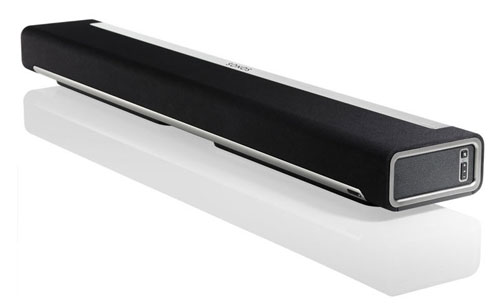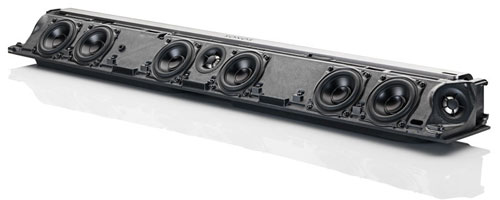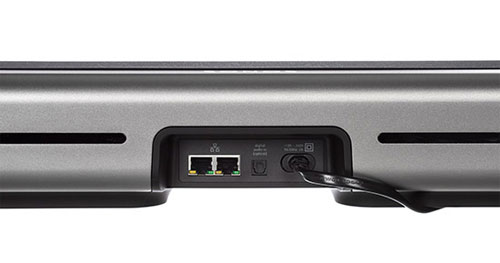Whenever the topic of multi-room audio comes up, one name that’s always at the top of the list is Sonos. With a single app, you can stream your entire music collection wirelessly throughout your home with the use of dedicated wireless speakers. Now the time has come for Sonos to throw their hat into the home cinema ring with the addition of the Sonos Playbar which has been blazing the trail in the fast-growing soundbar market.

Design
Hailed as the Ferrari of soundbars, the Sonos Playbar is a stunning piece of engineering which houses six midrange drivers and three tweeters. The bar itself acts like a left, right, and centre speaker with each one having its own tweeter and two midrange drivers. To create the wide soundstage, the right and left tweeters are mounted at an angle on the edge of the Playbar.

The Playbar itself is a seriously well-made equipment, constructed of gunmetal aluminium, and is finished with a plush black fabric cloth grill which encases the speakers. The Sonos is a beautiful looking speaker that simply oozes quality!
The Sonos Playbar is designed to be placed under your flat-screen TV, and can either be wall-mounted or laid flat on its back. With the soundbar being just a fraction over 3 inches tall when placed on its back, there’s no issue of it blocking your telly’s remote sensor, and at just over 35 inches wide, televisions of 42” and above would be more than happy with the Playbar sat beneath them.
Connections

The Sonos Playbar comes with 2 Ethernet connections and a single optical input. It requires you to connect all media devices to your existing display, and then connect the TV via the optical out to the soundbar. Because of the lack of an HDMI input, your HDTV must have an optical connection otherwise you will not be able to use the Playbar.
Set-Up
After unboxing the Playbar, the first thing to do is connect it to your internet modem or wireless router. If it’s located in the same room as the router you can simply plug in the supplied Ethernet cable and away you go. If your router isn’t in the same room, you will need to connect a Sonos Bridge to the router. It’s worth noting that the the Playbar doesn’t ship with the Bridge included – you’ll have to buy this separately at a cost of £39.99. Having the Bridge connected, the next thing to do is download the Sonos app to both configure the Playbar and operate it. For those without access to a smartphone or tablet, you can download the app to a PC or laptop.
Once the application is installed, the setup wizard is easy to follow, as it’s just a case of following the prompts on screen. The first thing is to connect the Bridge to your WiFi network, which just involves pressing a button on the device itself when the wizard asks you to. At each step you get a green tick to say everything is working correctly.
The next thing is to connect the Playbar itself which simply involves holding down the [Mute] and [Volume +] buttons on the player. At this stage you’re connected with only a few more screens to go until you’re up and running. The other choice the wizard gives you is to tell it which room the Playbar is in, then asks if you’d like to add a subwoofer or other speakers into the mix (we didn’t). If in the future you do want to add more speakers in different rooms (or even the same room), it’s just a case of opening the Sonos app and following the prompts on screen. The Sonos allows you to then configure your existing TV remote to control the volume of the Playbar. Configuring the remote was easy – it just involves pressing the volume button on your television remote when the Sonos wizard asks you to.
Once connected the Sonos will play music files stored on your computer or mobile device, as well as access an incredible amount of music from internet radio stations, and an infinite amount of tracks from the likes of Spotify, Napster, and many more. You can also add your own library and create playlists at your disposal. The interface is clean and nicely laid-out – navigation was super-easy.
So now we’re set up, how does it sound?…..
Sound Quality
What the Sonos Playbar does really well is creating the illusion of surround sound, with one of the best virtual surround processors we’ve heard to date. What is confusing is that most other soundbar manufacturers can’t stop banging on about their virtual surround sound, but Sonos are quite reserved about it, and there’s no mention of this effect on the packaging or on any of the literature that comes with the Playbar. Believe us it’s there and it should be shouted about! Before we get too excited, it doesn’t give the illusion of sound behind you, but it certainly made us feel that sound was coming from not only the front but from the sides. The logo intro which graces the beginning of Sony’s Blu-ray movies sounded fantastic, with every sparkle of sound enveloping our listening position.
Next, it’s time to see how the Playbar handled movie soundtracks. The Sonos soundbar created a wide dynamic soundstage brimming with plenty of detail when we spun the campus scene from The Incredible Hulk Blu-ray disc. However, bass handling wasn’t the best, and would benefit from a sub if you’re thinking of buying the Playbar to watch movies.
The Sonos app comes with a EQ offering bass and treble adjustments, as well as a loudness button. Disabling the loudness button and tweaking the EQ cleaned things up a bit, though compensating for the less-than-stellar bass response left us with a somewhat thin sound. No doubt a sub would’ve helped free up the Playbar to do what it does best, which is the handling of midrange and high frequencies.
Sonos Playbar handled music much better than it did film soundtracks. We played a variety of genres from classical to heavy rock music to see how the soundbar coped, and on the whole it fared well. We preferred the sound of the Playbar in its upright position as if it was wall-mounted rather than lying on its back, as this led to a more open soundstage. The only issue was that it then blocked the TV’s remote sensor, but the improvement in the sound was a worthwhile trade-off in our books. The Playbar delivered high frequencies with crystal clear precision, spreading the soundstage across the entire room, though bass extension could have been better.
Verdict
For those who would like to upgrade their flat-panel TV’s speakers for everyday use, you’ll be more than happy with the Sonos Playbar. It’s beautifully designed and nothing can touch it when it comes to its music streaming ability, content, and features. However, you’re a movie fan and want the best sound from your soundtracks, you’re really going to have to add a subwoofer to get the best out of it. The only problem is that it’s going to set you back another £599 and if you want to add a pair of Play:3 or the new Play:1 speakers to the mix to get a 5.1 setup, the whole package could set you back anywhere up to £1700. Another issue for movie lovers is that even after adding more speakers to run everything in 5.1, the Sonos cannot decode DTS soundtracks (which is a disappointment), and one that may put some potential buyers off.

